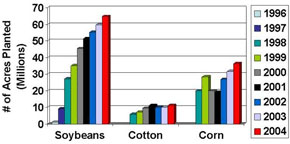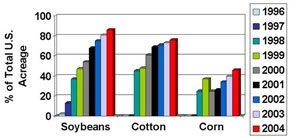Dr. Michael J. Phillips, vice
president, food and agriculture, science and regulatory
policy, of the Biotechnology
Industry Organization (BIO), issued the following
statement in response to today’s release of the U.S.
Department of Agriculture’s National Agricultural Statistics
Survey grower planting intentions survey for 2004.
“Today’s grower survey confirms
the continued acceptance of biotech crops by U.S. farmers and
their recognition of the economic, agronomic and environmental
advantages of biotech crops. Since their introduction in
1996, there has been a yearly increase in the number of acres
planted with biotech seeds in nearly every crop category.
Farmers, when given access to these improved crops, continue
to choose the biotech alternative.
“The use of biotech crops
continues to rise in the United States, evidence that farmers
have found that biotechnology can improve crops’ resistance to
disease and pests, increase yields and reduce the use of
pesticides. With the introduction of new pest-resistant
products last year, acreage of biotech corn plantings are up
9.7 percent to 46 percent of all corn planted in the U.S.;
biotech soybean acreage increased 9.2 percent to 86 percent of
all plantings; and biotech cotton acreage increased 9.1
percent to 76 percent of all plantings.
“The
last year has seen an increased acceptance of agricultural
biotechnology globally with biotech crops planted in 18
countries on more than 167 million acres, with a 15 percent
increase in 2003 over 2002.”
| Biotech
crop plantings in the US |
Biotech
crops: % of plantings (USA) |
 |
 |
1999 figures are baed on a
survey of BIO member seed sales
2000-2003 figures are based on USDA/NASS
2004 figures are estimates of USDA/NASS, 31 March 2004 |
BIO represents more than 1,000
biotechnology companies, academic institutions, state
biotechnology centers and related organizations in all 50 U.S.
states and 33 other nations. BIO members are involved in the
research and development of health-care, agricultural,
industrial and environmental biotechnology products.
The USDA report is at
www.usda.gov/nass/PUBS/TODAYRPT/pspl0304.pdf